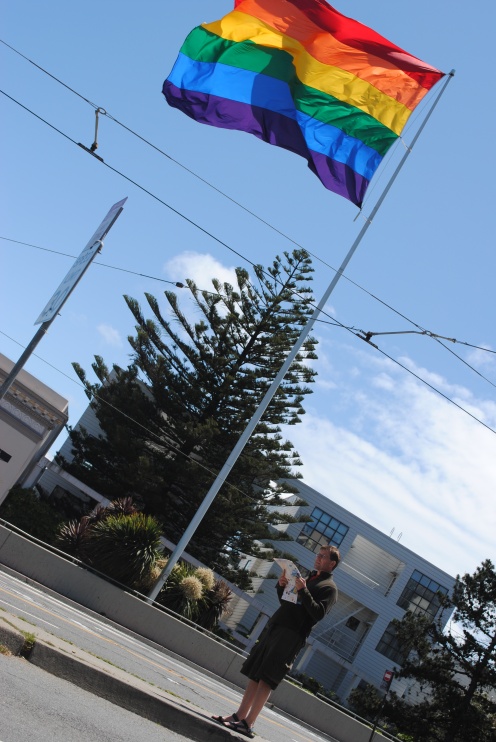Hayley Steel
Final Project Write-Up
Communication 125
December 12, 2012
Generations of Hope:
A documentary of the Gay Pride Movement in the San Francisco Bay Area
Kate O’Regan and I decided to create a video of the progression of the Gay Pride Movement, focusing especially on the San Francisco Bay Area. This social justice topic has been, and continues to be, a prevalent issue of human rights within our country. With the expansion of mass media, the coverage surrounding the movement has become more available to every American household. Kate and I chose to begin our project by highlighting Harvey Milk, the first openly gay, officially elected public official in the United States. Milk’s message, “Got to give them hope”, and his eventual assassination, helped to open the eyes of the ignorant in the United States. Our project briefly shows examples of the media coverage of homosexuals over the past sixty years and how it has transformed. Our goal was to juxtapose two eras that have very different messages. For example, the 1950’s public television message warning young boys against “the overfriendly homosexual”, compared to the 1995 Ikea advertisement, which was the first ad to feature a homosexual couple. We want to show how the media messages surrounding homosexuality have transformed largely in part to social mobilization through new media.
New social movement theory focuses on the idea that social movements, including the gay-pride movement, have become more widespread and more common since the 1960‘s. According to Leah A. Lievrouw’s book Alternative and Activist New Media, “The ‘new’ social movements perspective contends that the ideologically driven, society-wide movements of the industrial age-[…]-gave way in the postindustrial, postmodern era of the 1960’s to the 1980’s to smaller-scale movements more focused on wide-ranging issues or concerns, or group identity or lifestyle”(Lievrouw, pg.42). The development of mass communication has allowed for mass mobilization, therefore, the efforts made by Harvey Milk were successfully able to reach all areas of the United States. Mass mobilization also helped to create a community of people across the country, fighting for a common purpose. San Francisco was at the heart of the gay-pride movement, but new media allowed for people in New York, and every city in between, to be apart of the movement. “In new social movements, mobilization is accomplished by cultivating collective identities, shared values, and a sense of belonging among people linked in diffuse, decentralized social and community networks. Activists generate and share symbolic representations of movement identities and values that challenge those of the larger culture” (Lievrouw, pg.155). In the opening speech of our video, Milk talks about a faceless, nameless, young boy somewhere in the country who is struggling with his sexuality. By suggesting that homosexuals may be in your community, or may even be your child, is an example of the symbolic representations used to challenge the larger culture which was primarily homophobic at this time. This idea of a homosexual being someone that you know or someone that you love contradicts the idea that homosexuals are “the others”, but rather that they are people who are widely integrated in the community.
Harvey Milk is an example of new social activist because he did not hide his homosexuality. He was open about himself in his political endeavors and he showed the country a side of homosexuality that was not often exposed at the time. “Activists in new social movements tend to live their lives in a way that reflects their political, social, and ethical values, and to engage in movement actions and commitments according to issues of the moment, framed within their larger concerns, shared values, and collective identities” (153). Milk used his political power and influence to promote and acceptance of homosexuals and to promote equal rights for all people.
In 1994, the Swedish furniture company, Ikea, aired the first ever advertisement featuring a gay couple. The ad was removed from the air after being aired only a few times because certain stores received bomb threats because of it. Since then, the media has featured more and more homosexual couples in ads, television shows, and movies. Shows such as Will & Grace, which aired in 1998, challenged the segregation of homosexuals and heterosexuals by focusing the whole show on a homosexual man and his friendship with a heterosexual woman. Companies such as JCPenney, Cartier, and Levi have, since then, produced ads featuring homosexual couples. This shows an obvious progression in the widespread acceptance of homosexual lifestyles, however, gay couples also provide brands with a new group to target. The typical American household featuring a mother a father and two children has arguably become obsolete and boring. According to Henry Jenkins’ Convergence Culture, “Redundancy burns up fan interest and causes franchises to fail. Offering new levels of insight and experience refreshes the franchise and sustains consumer loyalty. […]. Different media attracts different market niches” (Jenkins, 98). Featuring a homosexual couple in an ad or in a television show is obviously meant to convey that a certain brand or network is “gay-friendly”. Therefore that company or network is targeting a growing family dynamic, one in which there are often times two disposable incomes and no children.
According to The Medium Is the Massage, “In an electronic information environment, minority groups can no longer be contained-ignored. Too many people know too much about each other. Our new environment compels commitment and participation. We have become irrevocably involved with, and responsible for, each other” (McLuhan, pg. 24). By creating a “global village”, the media has given homosexuals a voice and has given them a face. The media is no longer controlled solely by the dominant class, which means that the homosexual community can no longer be shown as “the others” or in only a negative light.
Work Cited
Jenkins, Henry. Convergence Culture. New York: New York University Press, 2006. Print
Lievrouw, Leah A.. Alternative and Activist New Media. Cambridge: Polity Press, 2011. Print
McLuhan, Marshall. The Medium Is the Message. Corte Madera: Gingko Press Inc, 1967. Print


